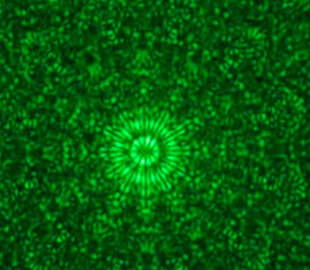
The breakthrough by the team of scientists was made possible by manipulating metal nanoparticles using an electric field to form a unique pattern called a “quasicrystal.”
Researchers from Aalto University have developed a method for creating “vortices” of light — small spirals of light energy that have the potential to significantly expand data capacity. Interesting Engineering writes about this.
Modern communication relies heavily on the encoding of information on different media, with laser light transmitted over fiber optic cables being one of the most common methods. However, as the demand for data transmission grew, the need for more efficient encoding methods became urgent.
“This study is about the relationship between symmetry and vortex rotation, that is, what kinds of vortices can we generate with what kinds of symmetry . Our quasi-crystalline structure is halfway between order and chaos,” — says Pjavi Termja, one of the authors of the study.
These tiny swirls of light look like hurricanes in a laser beam, with a calm dark center surrounded by a bright ring, something like the eye of a storm. In this case, the vortex is formed because the electric field of light flows in different directions around the center, creating a characteristic pattern that can carry information.
Aalto's team's breakthrough came from manipulating metal nanoparticles with an electric field to form a unique pattern called a “quasi-crystal.” Quasicrystals do not fit into conventional geometric categories; they exhibit a pattern that is regular but never repeats, opening up new possibilities for encoding information.
By manipulating the symmetry within these quasicrystals, researchers can create complex light vortices that carry different types of encoded information.
p>
200% Deposit Bonus up to €3,000 180% First Deposit Bonus up to $20,000Historically, scientists have known that the geometry of a material at the nanoscale affects the type of vortices it produces. Simple shapes like squares generate basic single vortices, while hexagonal patterns produce double vortices, and even more complex shapes require octagonal arrangements.
But until now, creating more complex vortices to encode data has been a challenge. Aalto's team's project overcomes these limitations, opening up the possibility to create vortices of any complexity, which could revolutionize the encoding and transmission of data.
In their experiment, the team manipulated 100,000 metal nanoparticles, each about one-hundredth the width of a human hair. Instead of placing the particles in high-energy hot spots within the electric field, they strategically placed them in “dead zones” of minimal interaction.
By avoiding areas of high vibration, the researchers could fine-tune the electric field to create desired vortices with specific characteristics .
Taskinen explains this as a counterintuitive but effective approach: “The electric field has high-vibration hot spots and points where it's essentially dead. We injected particles into the dead spots, which turned off everything else and allowed us to select the field with the most interesting properties for the applications.” , — says Taskinen in a press release.
This breakthrough could pave the way for expanding data transmission capabilities in light-encoding industries such as telecommunications.
These vortices can be transmitted over optical fibers, Arjas said. cables and decoded at the destination, allowing much more data to be stored and transmitted within a lower bandwidth. Early estimates show that this technology could increase fiber optic data throughput by 8 to 16 times compared to current methods.
While practical applications of this discovery may still be years away, this technology represents a promising foundation for future advancements.
Scaling up this approach for widespread use will require significant engineering effort, but the quantum dynamics group at Aalto is already immersed in related fields of research, including superconductivity and achievements in the field of organic LEDs.

